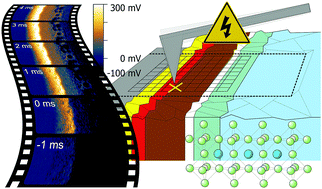当前位置:
X-MOL 学术
›
Energy Environ. Sci.
›
论文详情
Our official English website, www.x-mol.net, welcomes your
feedback! (Note: you will need to create a separate account there.)
How the formation of interfacial charge causes hysteresis in perovskite solar cells†
Energy & Environmental Science ( IF 32.4 ) Pub Date : 2018-06-05 00:00:00 , DOI: 10.1039/c8ee01447g Stefan A. L. Weber 1, 2, 3, 4, 5 , Ilka M. Hermes 1, 2, 3 , Silver-Hamill Turren-Cruz 6, 7, 8, 9, 10 , Christopher Gort 1, 2, 3 , Victor W. Bergmann 1, 2, 3 , Laurent Gilson 1, 2, 3 , Anders Hagfeldt 6, 7, 8, 9, 10 , Michael Graetzel 7, 8, 9, 10, 11 , Wolfgang Tress 6, 7, 8, 9, 10 , Rüdiger Berger 1, 2, 3
Energy & Environmental Science ( IF 32.4 ) Pub Date : 2018-06-05 00:00:00 , DOI: 10.1039/c8ee01447g Stefan A. L. Weber 1, 2, 3, 4, 5 , Ilka M. Hermes 1, 2, 3 , Silver-Hamill Turren-Cruz 6, 7, 8, 9, 10 , Christopher Gort 1, 2, 3 , Victor W. Bergmann 1, 2, 3 , Laurent Gilson 1, 2, 3 , Anders Hagfeldt 6, 7, 8, 9, 10 , Michael Graetzel 7, 8, 9, 10, 11 , Wolfgang Tress 6, 7, 8, 9, 10 , Rüdiger Berger 1, 2, 3
Affiliation

|
In this study, we discuss the underlying mechanism of the current–voltage hysteresis in a hybrid lead-halide perovskite solar cell. We have developed a method based on Kelvin probe force microscopy that enables mapping charge redistribution in an operating device upon a voltage- or light pulse with sub-millisecond resolution. We observed the formation of a localized interfacial charge at the anode interface, which screened most of the electric field in the cell. The formation of this charge happened within 10 ms after applying a forward voltage to the device. After switching off the forward voltage, however, these interfacial charges were stable for over 500 ms and created a reverse electric field in the cell. This reverse electric field directly explains higher photocurrents during reverse bias scans by electric field-assisted charge carrier extraction. Although we found evidence for the presence of mobile ions in the perovskite layer during the voltage pulse, the corresponding ionic field contributed only less than 10% to the screening. Our observation of a time-dependent ion concentration in the perovskite layer suggests that iodide ions adsorbed and became neutralized at the hole-selective spiro-OMeTAD electrode. We thereby show that instead of the slow migration of mobile ions, the formation and the release of interfacial charges is the dominating factor for current–voltage hysteresis.
中文翻译:

界面电荷的形成如何导致钙钛矿型太阳能电池的滞后现象†
在这项研究中,我们讨论了混合钙钛矿型铅酸铅太阳能电池中电流-电压滞后的潜在机理。我们已经开发了一种基于开尔文探针力显微镜的方法,该方法可以将电荷重新分布映射到具有亚毫秒分辨率的电压或光脉冲上的操作设备中。我们观察到在阳极界面处形成了局部界面电荷,从而屏蔽了电池中的大部分电场。在向器件施加正向电压后的10毫秒内会形成此电荷。但是,在关闭正向电压后,这些界面电荷会稳定500毫秒以上,并在电池中产生反向电场。该反向电场通过电场辅助电荷载流子提取直接解释了反向偏置扫描期间较高的光电流。尽管我们发现在电压脉冲期间钙钛矿层中存在可移动离子的证据,但相应的离子场对筛选的贡献仅不到10%。我们对钙钛矿层中随时间变化的离子浓度的观察表明,碘离子在空穴选择性螺-OMeTAD电极上吸附并被中和。因此,我们证明,界面电荷的形成和释放不是流动离子的缓慢迁移,而是电流-电压磁滞的主要因素。相应的离子场对筛选的贡献仅不到10%。我们对钙钛矿层中随时间变化的离子浓度的观察表明,碘离子在空穴选择性螺-OMeTAD电极上吸附并被中和。因此,我们证明,界面电荷的形成和释放不是流动离子的缓慢迁移,而是电流-电压磁滞的主要因素。相应的离子场对筛选的贡献仅不到10%。我们对钙钛矿层中随时间变化的离子浓度的观察表明,碘离子在空穴选择性螺-OMeTAD电极上吸附并被中和。因此,我们证明,界面电荷的形成和释放不是流动离子的缓慢迁移,而是电流-电压磁滞的主要因素。
更新日期:2018-06-05
中文翻译:

界面电荷的形成如何导致钙钛矿型太阳能电池的滞后现象†
在这项研究中,我们讨论了混合钙钛矿型铅酸铅太阳能电池中电流-电压滞后的潜在机理。我们已经开发了一种基于开尔文探针力显微镜的方法,该方法可以将电荷重新分布映射到具有亚毫秒分辨率的电压或光脉冲上的操作设备中。我们观察到在阳极界面处形成了局部界面电荷,从而屏蔽了电池中的大部分电场。在向器件施加正向电压后的10毫秒内会形成此电荷。但是,在关闭正向电压后,这些界面电荷会稳定500毫秒以上,并在电池中产生反向电场。该反向电场通过电场辅助电荷载流子提取直接解释了反向偏置扫描期间较高的光电流。尽管我们发现在电压脉冲期间钙钛矿层中存在可移动离子的证据,但相应的离子场对筛选的贡献仅不到10%。我们对钙钛矿层中随时间变化的离子浓度的观察表明,碘离子在空穴选择性螺-OMeTAD电极上吸附并被中和。因此,我们证明,界面电荷的形成和释放不是流动离子的缓慢迁移,而是电流-电压磁滞的主要因素。相应的离子场对筛选的贡献仅不到10%。我们对钙钛矿层中随时间变化的离子浓度的观察表明,碘离子在空穴选择性螺-OMeTAD电极上吸附并被中和。因此,我们证明,界面电荷的形成和释放不是流动离子的缓慢迁移,而是电流-电压磁滞的主要因素。相应的离子场对筛选的贡献仅不到10%。我们对钙钛矿层中随时间变化的离子浓度的观察表明,碘离子在空穴选择性螺-OMeTAD电极上吸附并被中和。因此,我们证明,界面电荷的形成和释放不是流动离子的缓慢迁移,而是电流-电压磁滞的主要因素。











































 京公网安备 11010802027423号
京公网安备 11010802027423号